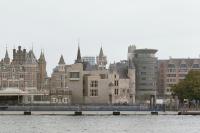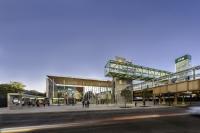Gelephu International Airport
Gelephu, Bhutan
Bhutan’s second international airport, the Gelephu International Airport is strategically positioned near the Bhutan-Indian border and the Paitha River, surrounded by Bhutan’s lush subtropical forests, mountains, and rivers. Spanning 68,000 m2, the airport is a collaboration with aviation engineering firm NACO and an integral part of the Gelephu Mindfulness City (GMC) masterplan designed by BIG, Arup, and Cistri. With the capacity to handle 123 flights daily, the airport is projected to welcome 1.3 million passengers annually by 2040, increasing to 5.5 million passengers by 2065. An installation at Venice Architecture Biennale 2025 will feature a timber diamond piece reflecting the airport’s façade. Sculpted in real time, half by a Bhutanese artist, and half by machine, the exhibit merges tradition with innovation, celebrating Bhutan’s wood carving heritage while exploring technology’s role in preserving and advancing the craft.
Set against a backdrop of the Himalayas, the airport’s diagrid structure is crafted from locally and sustainably sourced timber and adorned with traditional Bhutanese woodcarvings by local artists. The painted façade draws inspiration from the ‘Kachen,’ a wooden pillar revered for its structural significance and intricate design, embodying Bhutanese architectural heritage and spiritual symbolism.
Designed to accommodate GMC’s projected growth, the airport’s timber frames are structurally independent, allowing for simple disassembly and expansion. The airport’s roof features PV panels, in line with Bhutan's position as a carbon-negative nation.
Harmoniously blending into the surrounding natural terrain, the arrival plaza is designed as a series of four zones each dedicated to specific plants found within the forests in Gelephu. A gathering space features paving made from local natural stone and integrated seating areas, while abundant greenery and a canopy provide protection from the elements.
Bhutan's biodiversity corridors are pulled into the airport and its interior courtyard. Aptly named the Forest Spine, the courtyard divides the terminal into two sections, with domestic flights on the west side and international flights to the east. Visually accessible from anywhere in the airport, the Forest Spine offers travelers a connection to nature even inside the airport, with tranquil green spaces, a treetop walkway, and indigenous fauna.
Every aspect of the Gelephu International Airport is a celebration of Bhutanese culture, showcasing regional craftsmanship including Shing-Zo (carpentry), Par-Zo (carving), Lha-Zo (painting), and Tshar-Zo (traditional weaving techniques). The traditional Bhutanese carvings extend from exterior to interior. Designed to instill mindfulness into the often-stressful experience of traveling, the airport is bathed in natural light, with a grand triple-height entry, expansive floor-to-ceiling windows, and skylights. Indoor and outdoor lounges provide tranquil spaces for yoga, gong baths, and meditation for travelers to recenter and recharge, embodying Bhutan’s values of happiness and psychological well-being.
The Gelephu International Airport’s layout is driven by passenger experience and operational efficiency. Intuitive wayfinding through clear visual cues and thoughtfully designed circulation paths ensures a smooth journey from arrival to gate. Gates are situated on the upper level alongside retail and food and beverage areas, offering expansive views of the apron and the dramatic Himalayan landscape.
Adapting to the subtropical climate of Southern Bhutan, the airport incorporates climate-responsive, passive designs seen in traditional Bhutanese architecture. Its wooden structure absorbs moisture from the air, helping to regulate indoor humidity, while ventilated roofs and courtyards encourage natural airflow. Outside, extended eaves provide shade and protect against heavy rainfall. The airport will also become Bhutan’s first in-land mobility hub, promoting the use of public transportation with easily accessible trackless trams and buses that connect to Gelephu’s revitalized town center and the rest of the country.
Grounded in Bhutanese culture, the Gelephu International Airport aims to establish itself as a global gateway into GMC that honors history while embracing the future, creating a welcoming atmosphere that reflects the spirit of GMC at every stage of the journey. The airport is set to open in 2029.
- Architekten
- BIG – Bjarke Ingels Group
- Standort
- Gelephu, Bhutan
- Jahr
- 2025
- Bauherrschaft
- The Kingdom of Bhutan
- Team
- Bjarke Ingels, Frederik Lyng, Giulia Frittoli, Per Bo Madsen, Sorcha Burke, Dace Gurecka, Andrea Megan Hektor, Chiara Gargiulo, Dalma Ujvari, Jan Magasanik, Mantas Povilaika, Nanna Gyldholm Møller, Nathan Angelo Osena, Nikol Maraj, Will Chuanrui Yu, Xinyu Zhao, Matthew Goodwill
- Collaborators
- Netherlands Airport Consultants (NACO), Magnolia Quality Development Corporation Limited (MQDC), Changi Airport Planners and Engineers, Influit, WT Partnership


















